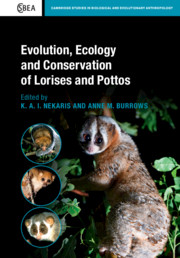Book contents
- Evolution, Ecology and Conservation of Lorises and Pottos
- Cambridge Studies in Biological and Evolutionary Anthropology
- Evolution, Ecology and Conservation of Lorises and Pottos
- Copyright page
- Dedication
- Contents
- Contributors
- Foreword
- Acknowledgements
- 1 Introduction
- Part I Evolution, Morphology and the Fossil Record
- 2 Sluggards and Drunkards?
- 3 What We Know (and Don’t Know) About the Fossil Records of Lorisids
- 4 Outliers
- 5 Molecular Advances in Lorisid Taxonomy and Phylogeny
- 6 The Toothcomb of Karanisia clarki
- 7 The Soft-Tissue Anatomy of the Highly Derived Hand of Perodicticus Relative to the More Generalised Nycticebus
- 8 Making Scents of Olfactory Sensitivity in Lorises and Pottos
- 9 Allometric and Phylogenetic Diversity in Lorisiform Orbit Orientation
- 10 The Evolution of Social Organisation in Lorisiformes
- 11 Biomechanics of Loris Locomotion
- 12 What Role Did Gum-Feeding Play in the Evolution of the Lorises?
- Part II Ecology and Captive Management
- Part III Research, Trade and Conservation
- References
- Index
11 - Biomechanics of Loris Locomotion
from Part I - Evolution, Morphology and the Fossil Record
Published online by Cambridge University Press: 29 February 2020
- Evolution, Ecology and Conservation of Lorises and Pottos
- Cambridge Studies in Biological and Evolutionary Anthropology
- Evolution, Ecology and Conservation of Lorises and Pottos
- Copyright page
- Dedication
- Contents
- Contributors
- Foreword
- Acknowledgements
- 1 Introduction
- Part I Evolution, Morphology and the Fossil Record
- 2 Sluggards and Drunkards?
- 3 What We Know (and Don’t Know) About the Fossil Records of Lorisids
- 4 Outliers
- 5 Molecular Advances in Lorisid Taxonomy and Phylogeny
- 6 The Toothcomb of Karanisia clarki
- 7 The Soft-Tissue Anatomy of the Highly Derived Hand of Perodicticus Relative to the More Generalised Nycticebus
- 8 Making Scents of Olfactory Sensitivity in Lorises and Pottos
- 9 Allometric and Phylogenetic Diversity in Lorisiform Orbit Orientation
- 10 The Evolution of Social Organisation in Lorisiformes
- 11 Biomechanics of Loris Locomotion
- 12 What Role Did Gum-Feeding Play in the Evolution of the Lorises?
- Part II Ecology and Captive Management
- Part III Research, Trade and Conservation
- References
- Index
Summary
Most primates exhibit a trio of locomotor characteristics during horizontal walking that distinguishes them from most other mammals. These unusual primate features include a preponderance of diagonal sequence (DS) gaits, large forelimb protraction at the shoulder and higher vertical peak forces on the hindlimbs than the forelimbs (Demes et al., 1994; Kimura, 1985, 1992; Kimura et al., 1979; Larson, 1998; Larson and Demes, 2011; Larson et al., 2000; Schmitt, 1999, 2003a, 2012; Schmitt and Hanna, 2004; Schmitt and Lemelin, 2002, 2004). Though this suite of features is not universal to primates (e.g. the common marmoset, Callithrix jacchus, exhibits a preponderance of lateral sequence [LS] gaits [Schmitt, 2003a]) nor unique to primates (e.g. the woolly opossum, Caluromys philander, exhibits all three ‘primate-like’ gait features [Schmitt and Lemelin, 2002]), it is thought that these three biomechanical features are related to the earliest origins and diversifications of the primate clade.
- Type
- Chapter
- Information
- Evolution, Ecology and Conservation of Lorises and Pottos , pp. 138 - 152Publisher: Cambridge University PressPrint publication year: 2020



